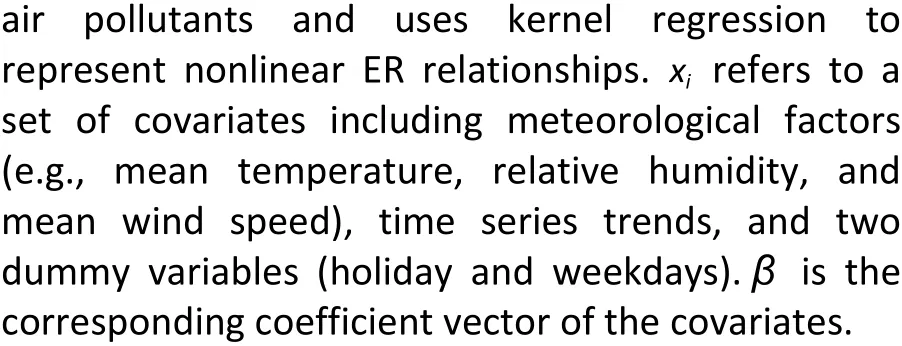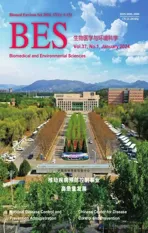Joint Effects of Multipollutant Mixtures on Mortality in Chengdu, China*
2024-02-26ZHANGYingTIANQiQiHUWenDongZHANGShaoBoWANGShiGongandZHENGCanJun
ZHANG Ying, TIAN Qi Qi, HU Wen Dong, ZHANG Shao Bo,WANG Shi Gong, and ZHENG Can Jun
Significant epidemiological research has revealed that exposure to air pollution is substantially associated with numerous detrimental health consequences[1-3].The negative health effects of individual air pollutants (e.g., fine particulate matter:PM2.5; nitrogen dioxide: NO2; carbon monoxide, CO;or ozone: O3) have been widely explored[4].However,humans are constantly exposed to multipollutant mixtures in real life, and biological responses to inhaled pollutants are likely to depend on the interplay of pollutant mixtures.Therefore, it is critical and imperative to explore the joint effects of multipollutant mixtures on human beings.
Recently, a new statistical learning method based on Bayesian kernel machine regression (BKMR) was proposed by Bobb et al.[1].The BKMR model can be utilized to assess not only the overall effects of multipollutant mixtures but also the interactions between different pollutant mixtures, accounting for the potentially nonlinear and nonadditive relationships between particular air pollutants and related health outcomes[1].Based on the remarkable advantages of this approach, some researchers have sought to apply this approach to investigate the relationships between mixed metals/chemicals and health outcomes such as hearing loss, gestational diabetes mellitus, and obesity and have achieved some new discoveries[5-7].However, to the best of my knowledge, the BKMR approach has not yet been used in time series studies of multipollutant mixtures on nonaccidental as well as cause-specific mortality.
Chengdu, one of the main cities in Southwest China, is situated at the base of the Sichuan Basin,which has severe air pollution issues as a result of high emissions and poor atmospheric diffusion conditions.Previous studies have reported that PM2.5, NO2, O3, and CO are the four principal air pollutants in Chengdu[8].It is not yet known how the four pollutant mixtures affect the health of the local population.Therefore, we employed the BKMR model to evaluate the individual and potential joint effects of the four major pollutants on nonaccidental, cardiovascular, and respiratory mortality in Chengdu, China, as well as the interaction effects among different air pollutants from Jan 1, 2014, to Dec 31, 2016.Specifically, we used BKMR to evaluate 1) the overall effect of the four pollutant mixtures on the three mortality categories; 2) the relative importance of each air pollutant in the mixture for a specific health outcome; 3) the interactions of various air pollutants on a specific health outcome.The BKMR model is as follows:


To ensure that the four air pollutants were at similar scales, the data of the four air pollutants were first standardized before fitting the BKMR model.To account for uncertainties resulting from ER functions and effects, we generated 95% credible intervals (CrIs, a Bayesian analogue to confidence intervals) around our estimations.All analyses were carried out in R 4.3.0 using the "bkmr" package,which allows visual description of the relationships between a particular health outcome and individual pollutant as well as a mixture of several pollutants.Specifically, the overall effect of multipollutant mixtures can be plotted by the estimated change in probability of a specific health outcome when all pollutants reach a certain percentile versus when all pollutants reach the 50th percentile.The univariate effects of a single pollutant in the mixture on a particular health outcome can be evaluated by calculating the change in probability of the health outcome when the pollutant changes from one percentile to another, while the other three air pollutants fixed at a given percentile (25th, 50th, and 75th).Furthermore, BKMR allows for the investigation of potential interaction effects among pollutants by contrasting the slopes of the estimated ER curves of one pollutant at various concentrations of the other pollutant.
As shown in Supplementary Table S1 (available in www.besjournal.com), there were 223 nonaccidental, 70 cardiovascular, and 55 respiratory deaths per day.The annual average temperature,RH, and mean wind speed were 16.76 °C, 81.67%,and 1.29 m/s, respectively.In addition, the annual average concentrations of PM2.5, O3, and NO2were 66.43, 89.22, and 54.32 µg/m3, respectively, and CO was 1.15 mg/m3.
Figure 1 depicts the overall effects of the four major pollutant mixtures on the three categories of mortality.The overall effects on nonaccidental,cardiovascular, and respiratory mortality all kept steadily increasing when the four air pollutants were concurrently elevated from the 25th to 75th percentiles.In particular, the overall effect was statistically significant when all four major pollutants were met or exceeded the 55th percentile, indicating that the combination of the four pollutants had a significant joint effect on the three mortality categories.
Figure 2 depicts the univariate effects of different air pollutants.By defining the concentrations of the other three air pollutants at the 25th, 50th, and 75th percentiles, PM2.5was found to be the only pollutant with a clear association with these three mortality categories.In addition, we observed that the higher the percentile(75th) of the other three pollutants, the stronger the positive association between PM2.5and the three mortality categories, which indicated the effect of PM2.5contributed most to the combined effects in mixtures.
Figure 3 displays the bivariate ER correlations of the effect of the four air pollutants on the three mortality categories.Exposure 2, which was in the 10th, 50th, and 90th percentiles of environmental exposure, is represented by each row.Each column lists the exposure to the environment that was being studied (Exposure 1), with the remaining variables set to their median value.We found that for PM2.5,O3, or CO exposure at the three NO2percentiles, the differences between the three ER curves are small and almost overlap for the same kind of air pollutant, indicating a lack of interaction effects between NO2and the other three pollutants.Notably, the ER curves of CO at various O3(or PM2.5)percentiles intersected, and vice versa, suggesting a potential interaction effect between CO and O3(or PM2.5).

Figure 1.Overall effects with 95% credible intervals (CrIs) of the four air pollutant mixtures (including PM2.5, O3, NO2, and CO exposures) on three mortality categories in Chengdu, China.
In this study, we investigated the relationships among mixtures of four major air pollutants (CO,NO2, PM2.5, and O3) and three categories mortality in Chengdu, China.Our findings suggested that combined exposure to multiple pollutants (O3, NO2,CO, and PM2.5) had significant effects on nonaccidental, cardiovascular, and respiratory mortality, mainly driven by PM2.5.Our findings was consistent with some prior studies[3,6,7].For example,a cohort study across 15 southeastern US cities examined the relationship between all-cause mortality and multipollutant mixtures (PM2.5, NO2,and O3)[6], which recognized that the combined effect of multipollutant mixtures was more comprehensive than that of any single pollutant and the effects of PM2.5dominated the combined effect.Another recent cross-sectional study conducted in eastern China evaluated the combined effect of several environmental exposures on obesity and found a dominant effect of PM2.5in the mixture combination on the change in body mass index(BMI), indicating the obesity index[7].However, the current existing research is still lacking.Therefore,much relevant research is still needed in the future.
The results of univariate effect research indicated that PM2.5, O3, and CO had positive effects on these three mortality categories.In particular,PM2.5was the only pollutant whose individual effect remained significant when the other three pollutants were changed from their 25th to 75th percentiles.In addition, NO2was the only air pollutant with a negative correlation, although the correlation effect was not significant (Figure 2).Previous studies have shown that the results of NO2risk were inconsistent with or even opposite to the results of our study[9].For instance, a nationwide time-series study across 272 major Chinese cities revealed that each 10 µg/m3increase in NO2would lead to 0.9%, 0.9%,and 1.2% increases in nonaccidental, cardiovascular,and respiratory mortality, respectively[9].It is critical to emphasize that the study mentioned above only looked at one pollutant without separating the effects of NO2from mixed pollutants.According to the World Health Organization[10], analyzing the individual health effects of NO2is difficult since it is typically highly connected with other air pollutants,which leads to the effect of NO2being masked by other source-related pollutants.
Research on the joint health effects of multiple pollutants has been a hot and difficult issue[3,5-7].BKMR allows for the investigation of potential interaction effects among pollutants by contrasting the slopes of the estimated ER curves of one pollutant at various concentrations of the other pollutant.This considerably simplifies the investigation of the interactions of numerous contaminants.According to our findings, there were significant interaction effects between CO and O3(or PM2.5) on the three mortality categories, but no interaction between NO2and the other air pollutants was found in Chengdu, China.These findings suggest that the government should develop regulations and approaches for the synergistic control of air pollutants to protect human health.

Figure 2.Estimated health effects and 95% CrIs of a single pollutant on nonaccidental, cardiovascular, and respiratory mortality when the other three pollutants were fixed at the same particular percentiles.

Figure 3.Bivariate exposure-response functions of the effect of every two exposures on three mortality categories.
#Correspondence should be addressed to ZHANG Shao Bo, E-mail: zsb@cuit.edu.cn
Biographical note of the first author: ZHANG Ying,female, born in 1988, PhD, Associate Professor, majoring in meteorological, environment and public health.
Received: August 21, 2023;
Accepted: October 20, 2023
杂志排行
Biomedical and Environmental Sciences的其它文章
- Correlation between Combined Urinary Metal Exposure and Grip Strength under Three Statistical Models: A Cross sectional Study in Rural Guangxi*
- Effects of Bisphenol A and lts Substitute, Bisphenol F, on the Gut Microbiota in Mice*
- The Uptake and Distribution Evidence of Nano- and Microplastics in vivo after a Single High Dose of Oral Exposure*
- The Effect and Mechanism of Fructus lycii on lmprovement of Exercise Fatigue Using a Network Pharmacological Approach with in vitro Experimental Verification*
- Quercetin Alleviates Lipopolysaccharide-lnduced Cardiac lnflammation via lnhibiting Autophagy and Programmed Cell Death*
- Exosome-Transmitted miR-224-5p Promotes Colorectal Cancer Cell Proliferation via Targeting ULK2 in p53-Dependent Manner*
